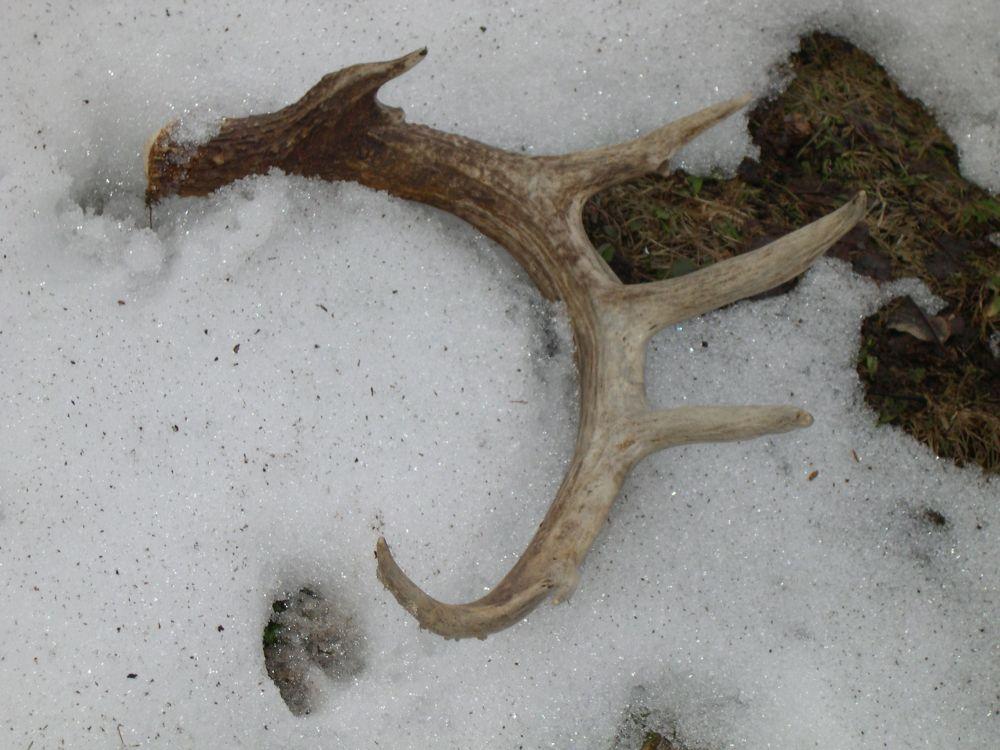- Tags:
- Wildlife,
- Something Wild

(Photo: Dave Anderson)
"Something Wild" is joint production of NH Audubon, The Society for the Protection of New Hampshire Forests & NHPR. We recommend listening to it in its original format via NHPR but a transcript of the show is also below. (Originally aired Dec. 3, 2021)
You can hear Something Wild on-air at NHPR every other Friday at 6:45 a.m. and 8:45 a.m., or subscribe to the Apple podcast here.
Shed antlers provide nutrients to a whole host of forest-dwellers, and are an important part of the entire forest ecosystem.
Deer and moose shed their antlers every year, so why don’t we find more of them scattered around in the woods when we’re out for a walk? Turns out we’re not the only ones looking for them. We might think of antlers mostly as a way to identify a male deer or moose, but antlers are an important part of the entire forest ecosystem.
Antlers are not horns. Antlers grow from the tip while horns grow from the base. Healthy antlers are a sign of a healthy animal. Males in the deer family, cervidae, include moose, deer and elk, and they grow new antlers every summer.
Antlers grow incredibly fast; it’s the fastest growing bone material of any mammal! At their peak, a white-tail deer’s antlers can grow a quarter inch per day. And a moose in his prime can grow as much as a pound of antler per day!
Developing antlers are covered in skin with a short, dense fur called velvet. Velvet allows oxygen-rich blood to nourish bone growth via an extensive capillary network. If you were to feel the growing antlers of a captive deer, you’d find they are actually warm! That’s because of the high level of blood flow.
The size of the antlers can tell you more than just the age of a white-tail buck or a bull moose. It’s an indication of fitness, good nutrition and good genetics. But the capacity for larger antlers does increase with body mass.

Their primary function is reproduction, as advertisement to the females. But they also serve as formidable weapons for territorial dominance in contests with rival males during the rut, their fall breeding season.
After the breeding season, antlers have served their purpose. They’re heavy and get in the way as the males walk through the woods. They are now more intent on eating enough to rebuild their strength to survive the winter.
Decreased daylight lowers testosterone, which causes the connection between antler and skull to weaken and the antlers to fall off. And they don’t necessarily both fall off at the same time!
In New Hampshire this typically happens in January, although it can vary. But that’s NOT the end of the story!
Antlers contain calcium which is vital for teeth and bones and supports nerve function, muscle contraction, and vision. Phosphorus helps produce protein for growth and organ function.
Shed antlers are a critical source of valuable nutrients that are often only found in small quantities in things like bark, twigs, buds, and leaves. Plants obtain these minerals from soils derived from weathering bedrock. But granite is notoriously stingy and thus our soils are nutrient poor. Calcium in particular is the limiting nutrient for forest growth in the state. And if it’s limiting for plants, it’s limiting for bone growth.
That makes shed antlers incredibly valuable to forest-dwellers.
Rodents like mice, chipmunks, and squirrels, as well as porcupines and raccoons, gnaw on shed antlers. The antlers often show teeth marks, evidence of nature’s elegant system of nutrient recycling. There are wildlife camera images documenting rabbits, opossums, coyotes and even deer chewing on antlers.
And that is why shed antlers are not so easy to find.
Something Wild is a joint production of New Hampshire Audubon, the Society for the Protection of New Hampshire Forests, and NHPR.
